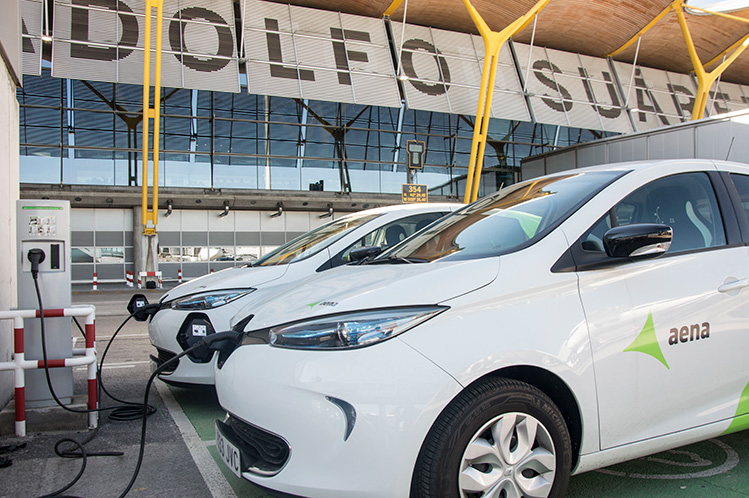An interview with Amparo Brea, Innovation, Sustainability and Client Experience Director, Aena. By Ross Falconer
The COVID-19 pandemic and its ramifications are posing a major challenge for the air transport industry’s survival. It is especially significant in Spain, with tourism accounting for more than 12% of national GDP and four in every five international visitors to the country arriving by air.

Amparo Brea, Innovation, Sustainability and Client Experience Director, Aena: “Driven by the speed at which new technologies are breaking into our industry, and backed by our innovation team, we felt we needed to refresh our climate change strategy and enlarge our objectives. So, this year we decided to bring our net zero carbon commitment forward to 2040.”
“This has made us realise, to an even greater extent, the importance of thinking ahead as a way to address the major threat of climate change, and we had it clear in our minds that the industry’s recovery plan had to factor in the ongoing climate and ecological crisis we are facing,” begins Amparo Brea, Innovation, Sustainability and Client Experience Director, Aena. “So, in terms of sustainability, and in spite of the current situation, our environmental performance is still a key priority in our management approach. As such, our strategic strands are built on the principle of green reconstruction, so we can accomplish our decarbonisation and environmental protection commitments by working in partnership with our stakeholders.”
As part of this commitment, Aena has signed up to the ‘Manifesto for Sustainable Recovery’ – a domestic initiative rooted in the EU’s Green Recovery Alliance which is supported by businesses, NGOs, scientists, academics, and the wider public. “It urges the government to find a way out of the coronavirus economic crisis which lays the foundations for transformation into a more sustainable and robust economy based on innovation and decarbonisation,” says Brea. “This is because we think that competitiveness and the environment go hand-in-hand, since without environmental sustainability there can be no economic or social sustainability.”
Technologically innovative projects to achieve carbon-neutrality
The current crisis is giving a major boost in terms of innovation and digitalisation in response to many of the needs that have emerged over recent months. Indeed, Brea explains that these developments are allowing Aena to plan new, more technologically innovative projects, which will contribute to achieving its carbon-neutrality commitments more swiftly.
Several of Aena’s airports are accredited under ACI’s Airport Carbon Accreditation, including five (Madrid-Barajas, Barcelona, Palma de Mallorca, Málaga, Lanzarote) at Level 2 Reduction. “We are going to increase the number of airports included in the programme, so that all of them reach carbon neutral Level 3+ by 2026,” Brea explains. “We have also committed to making all of our airports carbon neutral by that year in a global network programme, as an intermediate step towards achieving net zero by 2040.”
Key measures implemented as part of Aena’s climate change strategy currently include:
- More technology-based actions to increase energy efficiency in lighting and air conditioning (presence detectors, replacing conventional lighting with LEDs, upgrading air-conditioning systems, automatic lighting adjustment, etc)
- Buying 100% renewable energy with a guarantee of origin in all airports in the network, starting in 2020.
- A network of electric charging stations in car parks for passengers and employees, and replacing the Aena fleet with green vehicles.
Additionally, Aena launched one of its most ambitious projects to date: its Photovoltaic Plan. “We are now working on this scheme, which will enable us to achieve 100% self-supply of electricity from renewable sources at our airports by 2026,” says Brea.
The €350 million investment will produce 950 GWh per year of renewable energy, equivalent to the usage of 280,000 households. “The project is to be implemented through photovoltaic facilities in 14 of the company’s airports which have ample solar availability. It is unique in the industry in terms of the distribution system for the renewable energy fed into the grid of the 46 airports, and also the area of our facilities, which will cover more than 740 hectares.”

Aena is extending its Charging Station Plan. This initiative is already well underway and will allow airport users and employees to recharge their electric vehicles at Aena’s facilities.
Noise Insulation Plan and wildlife management
Aena is stepping up the noise mitigation measures taken at a local level, in order to achieve sustainable relationships with local communities. Its Noise Insulation Plan at airports stands out here, involving a €330.6 million investment in measures to mitigate the noise footprint between 2000 and 2019. “This means that more than 24,395 properties have already been soundproofed during this period and Aena has undertaken all the steps needed to fund these projects,” Brea explains.
Noise Monitoring Systems enhance noise control and management, while Madrid-Barajas and Barcelona-El Prat airports are the first in the world to publish noise data accredited by ENAC in conformity with the ISO 20906 standard. “These data are dumped in the airports’ Interactive Noise Maps and provide us with active and transparent communication with the most noise-sensitive communities around the airports,” Brea adds. “We also strive to foster dialogue with government authorities and environmental organisations by helping to draw up plans and strategies to minimise noise.”
Meanwhile, 24 of Aena’s airports share space with protected natural areas, with specific preservation measures undertaken to ensure operations are compatible with conserving natural heritage. “These measures include wildlife management, especially for birds, which is a key factor as it enables us to make protecting natural heritage compatible with maintaining security, safety and quality standards in aeronautical operations,” says Brea. “In this respect we regularly conduct studies on the wildlife around our airports, and their habitats, in partnership with local and regional organisations, and together with the Spanish Aviation Safety and Security Agency.”
Ambitious circular economy principles
Promoting sustainable transport options and intermodality is another key focus area for Aena, with the potential to significantly reduce energy usage and emissions generated.
Aena works with other tiers of government and relevant institutions to maintain a competitive transport system by seeking to integrate its infrastructure with other modes of transport, improving access, connections with the rail network, and town planning in airport environments.
“The most outstanding example is Barcelona-El Prat Airport, which has a specific Mobility Plan in place that includes measures such as setting up a working group with the Barcelona Metropolitan Area, drawing up an Action Plan to encourage sustainable mobility among our employees, connecting the airport with the town of El Prat de Llobregat by means of a bike lane, and installing ‘bicibox’, which is a network of cycle lockers,” Brea explains.
In line with circular economy principles at its main airports, Aena is analysing prospective construction plans for airport waste recovery plants to meet some of the demand for fuel. This includes producing sustainable aviation fuel, biomethane, pyrolysis oil, and even compost for reuse in landscaped areas.
“This is a very ambitious project, but we think airports have to play a role in the supply chain in order to scale up production of this type of alternative fuel, including the option of using airport waste, and closing their lifecycle in a way that is both circular and efficient,” Brea comments.
Indeed, as our interview draws to a close, it is clear that Aena is pursuing a comprehensive and collaborative approach to environmental sustainability. “Airports only account for a small part of total emissions in the aviation industry. This means we need to work closely with aircraft manufacturers, airlines, air traffic service providers, fuel producers, handling firms, and other partners and stakeholders, as a coordinated action group to put in place projects taking an integrated approach to the challenge of decarbonising the industry.”







